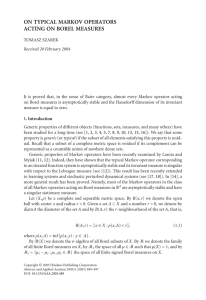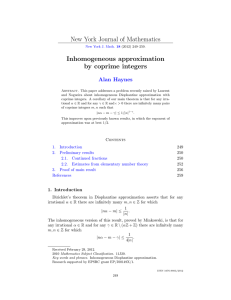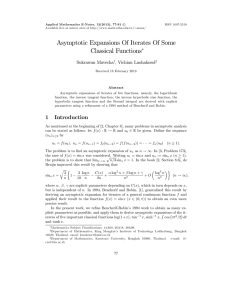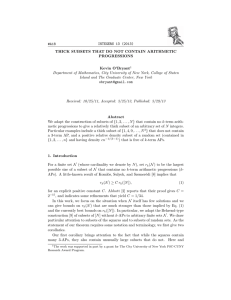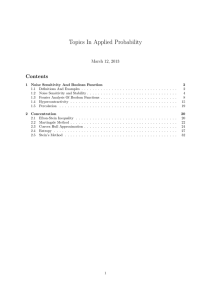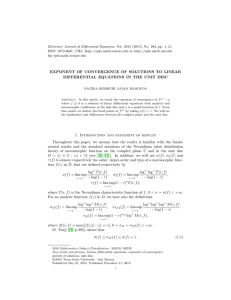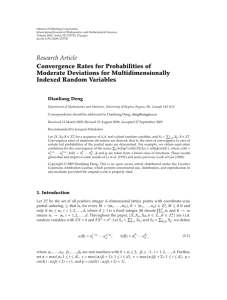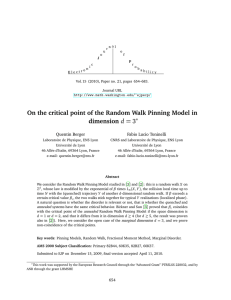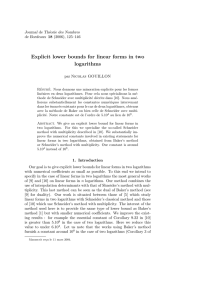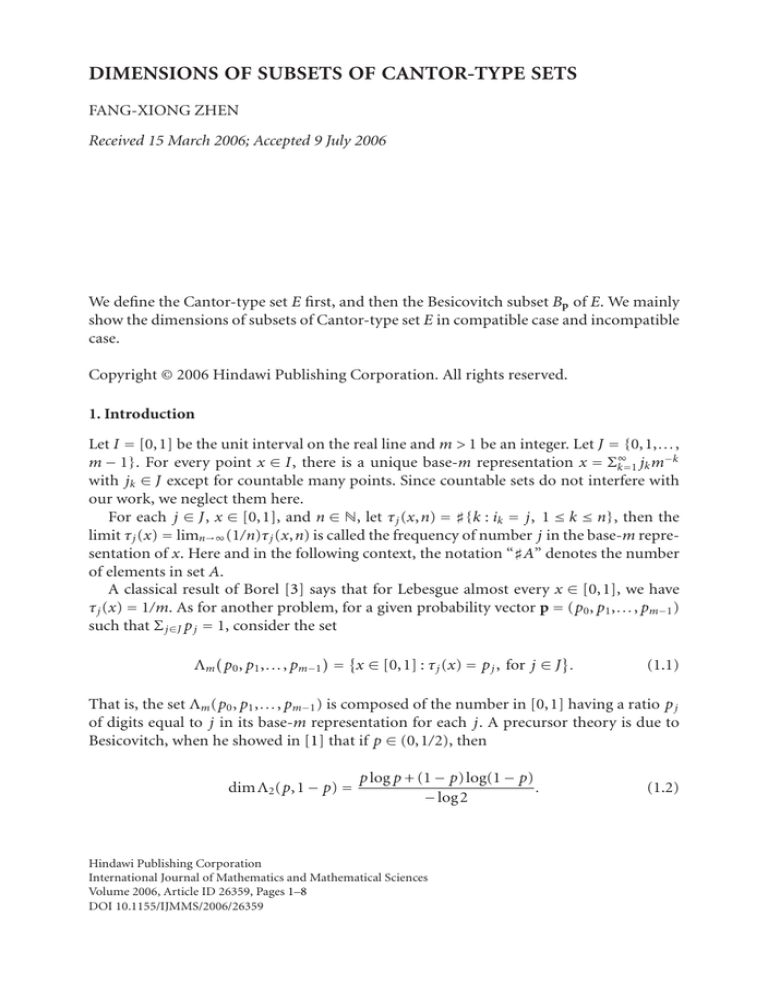
DIMENSIONS OF SUBSETS OF CANTOR-TYPE SETS
FANG-XIONG ZHEN
Received 15 March 2006; Accepted 9 July 2006
We define the Cantor-type set E first, and then the Besicovitch subset Bp of E. We mainly
show the dimensions of subsets of Cantor-type set E in compatible case and incompatible
case.
Copyright © 2006 Hindawi Publishing Corporation. All rights reserved.
1. Introduction
Let I = [0,1] be the unit interval on the real line and m > 1 be an integer. Let J = {0,1,...,
−k
m − 1}. For every point x ∈ I, there is a unique base-m representation x = Σ∞
k =1 j k m
with jk ∈ J except for countable many points. Since countable sets do not interfere with
our work, we neglect them here.
For each j ∈ J, x ∈ [0,1], and n ∈ N, let τ j (x,n) = {k : ik = j, 1 ≤ k ≤ n}, then the
limit τ j (x) = limn→∞ (1/n)τ j (x,n) is called the frequency of number j in the base-m representation of x. Here and in the following context, the notation “A” denotes the number
of elements in set A.
A classical result of Borel [3] says that for Lebesgue almost every x ∈ [0,1], we have
τ j (x) = 1/m. As for another problem, for a given probability vector p = (p0 , p1 ,... , pm−1 )
such that Σ j ∈J p j = 1, consider the set
Λm p0 , p1 ,..., pm−1 = x ∈ [0,1] : τ j (x) = p j , for j ∈ J .
(1.1)
That is, the set Λm (p0 , p1 ,..., pm−1 ) is composed of the number in [0,1] having a ratio p j
of digits equal to j in its base-m representation for each j. A precursor theory is due to
Besicovitch, when he showed in [1] that if p ∈ (0,1/2), then
dimΛ2 (p,1 − p) =
p log p + (1 − p)log(1 − p)
.
− log2
Hindawi Publishing Corporation
International Journal of Mathematics and Mathematical Sciences
Volume 2006, Article ID 26359, Pages 1–8
DOI 10.1155/IJMMS/2006/26359
(1.2)
2
Dimensions of subsets of cantor-type sets
Eggleston generalized this formula for m > 2. He showed in [4] that
dimΛm p0 , p1 ,... , pm−1 = −
Σ j ∈J p j log p j
.
logm
(1.3)
From then on, Λm (p0 , p1 ,..., pm−1 ) is called Besicovitch set. And later, Billingsley furthered their work and the related information can be found in his book [2].
The research developed in this paper is motivated by Morán and Rey’s work, and
some of the proofs are edified by the methods mentioned in their article [7]. Let M =
{1,2,...,m} and for any j ∈ M, ω = i1 i2 · · · in · · · ∈ M ∞ , n ∈ N, we define
δ j (ω,n) = k : ik = j, 1 ≤ k ≤ n .
(1.4)
Whenever there exists the limit
1
δ j (ω) = lim δ j (ω,n),
n→∞ n
(1.5)
it is called the frequency of number j in infinite length word ω. Then for a given probability vector p = (p1 , p2 ,..., pm ), we define the Besicovitch set Bp to be the subset of
Cantor-type set E (see Section 2) given by
Bp = ϕ(ω) : δ j (ω) = p j , ω ∈ M ∞ , for any j ∈ M .
(1.6)
Here ϕ is a bijective between M ∞ and the Cantor-type set E and M ∞ is the set of all
infinite length sequences consisted by M. A remark from [7] says that Bp is a Borel set.
In this paper, we give the Hausdorff dimension of Bp for any given probability vector
p = (p1 , p2 ,..., pm ) with p j > 0 for j ∈ M as the following theorem.
Theorem 1.1. Denote
p j log p j
,
j ∈M p j logr j
j ∈M
s= (1.7)
dimBp = s, and s ≤ α, where α is uniquely decided by Σ j ∈M r αj = 1. The equality is attained
when p coincides with (r1α ,r2α ,...,rmα ).
Furthermore, we will show that there exists a subset B of Besicovitch set Bp such that B
has full μp -measure (see Section 2) but zero Hausdorff measure when p = (r1α ,r2α ,...,rmα ),
which is described as follows.
Theorem 1.2. There exists a Borel subset B of Bp such that μp (B) = 1 and Ᏼs (B) = 0 in the
incompatible case, that is, p = (r1α ,r2α ,...,rmα ).
As a corollary of Theorem 1.2, we can easily have that μp , Ᏼα , and ᏼα are equivalent
on E in the compatible case, that is, p = (r1α ,r2α ,...,rmα ) (see Corollary 3.7). Furthermore,
we can get another byproduct (see Corollary 3.8) that the set E \ Bp has zero Ᏼα and
ᏼα -measure when p is substituted by (r1α ,r2α ,...,rmα ).
If the gap condition (see Section 2) holds, we will see that not only Bp and the Cantortype set E have the same Hausdorff measure and packing measure, but also both of them
Fang-Xiong Zhen 3
are α-sets in the case of p = (r1α ,r2α ,...,rmα ) (see Corollary 3.11). This can be regarded as
a corollary from Corollary 3.7. When it comes to the incompatible case, the Hausdorff
measure of Bp is infinity (Proposition 3.12), and so is the packing measure.
From Corollary 3.8, we see that the complementary of Bp with respect to E has zero
Ᏼα -measure in the compatible case, which implies that it is rather small from the viewpoint of measure theory.
The following section will give the basic definitions and notations of the paper, and
the proofs of the above results are displayed in Section 3.
2. Definitions and notations
of all sequences
Let I = [0,1] be the unit interval and M = {1,2,...,m}. Let Ωn be the set
of length n with each sequence consisting of letters in M and let Ω = ∞
n=1 Ωn . Suppose
that a sequence of closed subsets {Iω : ω ∈ Ωn } of I satisfies
(1) Iω∗i ⊂ Iω for any ω ∈ Ω and i ∈ M,
(2) Iω∗i ∩ Iω∗ j = φ for any ω ∈ Ω and i, j ∈ M with i = j,
(3) |Iω∗i |/ |Iω| = riwith ri ∈ (0,1) for any ω ∈ Ω and i ∈ M.
∞
= n=1 ω∈Ωn Iω is called a Cantor-type set.
Then the set E ∞
Notice that n=1 Ii1 i2 ···in consists of a single point which we will denote by ϕ(ω) since
ω ∈ Ωn , and we write Ii1 i2 ···in for Iω sometimes. We can easily see that ϕ : M ∞ → E is 1-1
and onto.
We denote by νp the probability measure on M ∞ defined by the infinite product p ×
p × p × · · · . Let μp be the projected measure supported by E, that is, μp = νp ◦ ϕ−1 , then
for any n-level basic interval Iω (ω = i1 i1 · · · in ∈ Ωn ), we have μp (Iω ) = Πnj=1 pi j . By the
strong law of large numbers, we see that μp (Bp ) = 1 and since Bp ⊂ E, thus μp (Bp ) =
μp (E) = 1. Such a measure μp is called Bernoulli measure.
For the use in next section, we give some notations here.
Let Ᏺ = {Iω : ω ∈ Ω}, we define
⎧
⎫
⎨ j⎬
j
j
j
s
s
(E) = inf ⎩ΣIω : Iω ⊂ Ᏺ, Iω ≤ δ, E ⊂ Iω ⎭ ,
Ᏼδ,Ᏺ
j
(2.1)
s
s
(E) = lim Ᏼδ,Ᏺ
(E).
ᏴᏲ
δ →0
Similar to the definition of Hausdorff dimension, we define
s
dimᏲ E = sup s ≥ 0 : ᏴᏲ
(E) = ∞
s
(E) = 0 .
= inf s ≥ 0 : ᏴᏲ
(2.2)
Now, we would like to define μsp -measure as follows:
⎧
⎨
μsp (E,δ) = inf ⎩Σμp
s
Ui : μp Ui ≤ δ, E ⊂
μsp (E) = lim μsp (E,δ)
δ →0
i
⎫
⎬
Ui ⎭ ,
(2.3)
4
Dimensions of subsets of cantor-type sets
then the μp -dimension of E is given by
dimμp E = sup s ≥ 0 : μsp (E) = ∞
= inf s ≥ 0 : μsp (E) = 0 .
(2.4)
We see that if μp (E) > 0, then dimμp E = 1.
3. Proofs
Now we set to prove the results displayed in Section 1. First, let us look at some lemmas.
Lemma 3.1 [5]. Suppose that p = (p1 , p2 ,..., pm ) is a probability vector with Σ j ∈M p j = 1
and p j > 0. For any q1 ,... , qm ∈ R,
m qi
Σm
i=1 pi − log pi + qi ≤ log Σi=1 e .
(3.1)
qi −1 for i ∈ M.
The equality is attained if and only if pi = eqi (Σm
i=1 e )
α
(F) ≤
Lemma 3.2. For any subset F ⊂ E, α ≥ 0, there exists a constant c > 0 such that cᏴᏲ
α
Ᏼα ≤ ᏴᏲ (F).
n
n−1 }. For any δ-covering {U }
Proof. Denote r = min1≤i≤m {ri }, A(n)
r = {Iω : r < |Iω | ≤ r
i
n
n
i
i −1 . For any x ∈ U , F ∩ U ⊂
of
F,
for
any
U
i , there exists ni such that r < |Ui | ≤ r
i
i
ni −1 ), then we have {I : I ∈ Ani I ∩ U = φ} ≤ 4r ni −1 /r ni =
n
r ω
ω
ω
i
Iω ∈Ar i Iω ∩Ui =φ Iω ⊂ B(x,2r
j =1,2,...,l
4/r, so for this Ui , there exists a sequence {Iinji }i=1,2,... i ⊂ Anr i such that F ∩ Ui ⊂ lji=1 Ii(nj i ) ,
li ≤ 4/r. Since |Ui | ≥ r ni ≥ r |Ii(nj i ) | for j = 1,2,...,li , then li |Ui |α ≥ Σlji=1 r α |Ii(nj i ) |α , we fur(ni ) α
li
α
α ∞
α
α+1 /4)Ᏼα (F). Letting
ther get (4/r)Σ∞
i=1 |Ui | ≥ r Σi=1 Σ j =1 |Ii j | , thus we get Ᏼ (F) ≥ (r
Ᏺ
α
α
(F) ≤ Ᏼα ≤ ᏴᏲ
(F).
c = r α+1 /4, we have cᏴᏲ
To prove Theorem 1.1, we need another lemma.
Lemma 3.3. If
log μp Iω
=δ ,
E ⊂ ϕ(ω) : lim
|ω|→∞ log Iω (3.2)
then dimE = δ dimμp E.
Proof. With Lemma 3.2, we can get the same dimension result if we use the basic intervals
to cover E, so we first prove that if
E ⊂ ϕ(ω) : liminf
|ω|→∞
logμp Iω
≥δ ,
log Iω (3.3)
then dim E ≥ δ dimμp E.
If ϕ(ω) ∈ E, then for any ε > 0, there exists N > 0 such that for any n > N, we have
μp (Iω ) ≤ |Iω |δ −ε . Thus there are only many finite ω such that Iω does not satisfy the above
Fang-Xiong Zhen 5
inequality. Let
Ek = ϕ(ω) ∈ E : Iω >
δ −ε
1
.
or μp Iω ≤ Iω k
(3.4)
We see that Ek is increasing. On the other hand, since we have μp (Iω ) > 0 for any ω ∈ Ω,
then there exists k such
that |Iω | > 1/k for any given ω ∈ Ω, which implies that ϕ(ω) ∈ Ek .
Thus we have E = k Ek .
j
For any (1/k >)ρ > 0, ε1 > 0, ε2 > 0, there exists a sequence of intervals {Iω } ⊂ Ᏺ such
j
j
j
that |Iω | ≤ ρ, Iω ∩ Ek = φ, and Ek ⊂ j Iω . Since dimᏲ E = dimE and Ek ⊂ E, we have
j
j
Ᏼρdim E+ε2 (Ek ) < ε1 , that is, Σ|Iω |dim E+ε2 < ε1 , which follows Σ(μp (Iω ))(dim E+ε2 )/(δ −ε) < ε1 .
Thus we have dimμp Ek ≤ (dimE + ε2 )/(δ − ε). Since ε and ε2 are arbitrary small, we have
dimE ≥ δ dimμp Ek , which further implies dim E ≥ δ dimμp E.
With the same method we can prove that if
logμp Iω
≤δ ,
E ⊂ ϕ(ω) : limsup
log Iω |ω|→∞
then dim E ≤ δ dimμp E.
With the above arguments, we complete the proof.
(3.5)
Proof of Theorem 1.1. For any ω ∈ Ω,
Σnj=1 log pi j
log μp Iω
= lim n
|ω|→∞ log Iω |ω|→∞ Σ j =1 log ri j
lim
Σ j ∈M δ j (ω,n)log p j
|ω|→∞ Σ j ∈M δ j (ω,n)logr j
= lim
=
(3.6)
Σ j ∈M p j log p j
= s.
Σ j ∈M p j logr j
Since μp (Bp ) = 1, by Lemma 3.3 we have dimBp = s.
Put qi = logriα in Lemma 3.1, we get s ≤ α. Furthermore, if we put
α
α
logri
pi = elogri Σm
i=1 e
−1
= riα ,
we have s = α.
(3.7)
Lemma 3.4 (law of iterated logarithm (Hartman-Winter)). Suppose that {Xn : n ≥ 1}
is a sequence of independent, identically distributed random variables (i.i.d.r.v.) satisfying
E(Xn ) = 0 and E(Xn2 ) = σ 2 ∈ (0,+∞), then
Σni=1 Xi
= 1,
limsup n→∞
2nσ 2 loglognσ 2
p a.e.,
Σni=1 Xi
= −1
liminf n→∞
2nσ 2 log lognσ 2
p a.e.
(3.8)
6
Dimensions of subsets of cantor-type sets
Remark 3.5. We suppose that E denotes the mathematical expectation and V denotes the
mean variance here and in the following context.
Proof of Theorem 1.2. Put p = μp ◦ ϕ, Xi = log pi − slog ri , i ∈ M, then {Xi } is a sequence
of i.i.d.r.v. with respect to p. We see that E(Xi ) = Σm
i=1 pi (log pi − slog ri ) = 0. Suppose that
p = (r1α ,...,rmα ), then
0 < E Xi2 = Σm
i=1 pi log pi − slog ri
2
=: σ 2 < ∞.
(3.9)
Set
Σni=1 Xi
=1 ,
B = ϕ(ω) : limsup n→∞
2nσ 2 log lognσ 2
(3.10)
then μp (B ) = 1 by Lemma 3.4. Since μp (Bp ) = 1. Let B = B ∩ Bp , we get μp (B) = 1.
With the above arguments, we see that Σ∞
j =1 Xi j = ∞ a.e., that is,
log
Πnj=1 pi j
−→ ∞,
Πnj=1 risj
as n −→ ∞,
(3.11)
from which we also have
μp Iω
s −→ ∞,
Iω as |ω| −→ ∞.
(3.12)
k
Let kn = {Iω : μp (Iω )/ |Iω |s > k, for ω ∈ Ωn }, k = ∞
n=1 n . For any δ > 0, k > 0, choose
k k
k
k
k
k
{I j } ⊂ such that B ⊂ j I j , |I j | ≤ δ, and Ii ∩ I j = φ(i = j). By the definition of k , we
have
μp I kj
k s > k,
I j
∀ j.
(3.13)
Thus
s 1
1
Ᏼδs (B) ≤ ΣI kj ≤ Σμp I kj ≤ .
k
k
Letting k → ∞, we have Ᏼδs (B) = 0, from which it follows that Ᏼs (B) = 0.
(3.14)
Lemma 3.6 [6]. Suppose that μ is a finite Borel measure such that
μ Iω
α < ∞ ,
0 < limsup Iω |ω|→∞
μ Iω
α < ∞ ,
0 < liminf |ω|→∞
Iω for any ω ∈ Ω,
then μ ∼ Ᏼα ∼ ᏼα on E.
Corollary 3.7. μp ∼ Ᏼα ∼ ᏼα on E in case of p = (r1α ,r2α ,...,rmα ).
(3.15)
Fang-Xiong Zhen 7
Proof. Since μp (Iω ) = Πnj=1 pi j , for ω = i1 i2 · · · in ∈ Ωn , then
Πnj=1 pi j
μp Iω
α = n α = 1,
Iω Π j =1 ri j
when p = r1α ,r2α ,...,rmα .
(3.16)
So by Lemma 3.6, we have μp ∼ Ᏼα ∼ ᏼα on E in case of p = (r1α ,r2α ,...,rmα ).
Ᏼα (E \ B
Corollary 3.8.
case of p = (r1α ,r2α ,...,rmα ).
p
) = ᏼα (E \ B
p ) = 0,
Ᏼα (E) = Ᏼα (B
p ),
and
ᏼα (E) = ᏼα (B
p)
in
Proof. By the definition of equivalence, μp ∼ Ᏼα on E ⇔ for any F ⊂ E, μp (F) = 0 ⇔
Ᏼα (F) = 0. It is clear that Bp is the subset of E with μp (E) = μp (Bp ) = 1, then we get
immediately μp (E \ Bp ) = 0, which further implies Ᏼα (E \ Bp ) = 0 by Corollary 3.7. Furthermore, Ᏼα (Bp ) ≤ Ᏼα (E) ≤ Ᏼα (Bp ) + Ᏼα (E \ Bp ) = Ᏼα (Bp ), we have Ᏼα (E) = Ᏼα (Bp ).
Similar arguments will prove that ᏼα (E \ Bp ) = 0 and ᏼα (E) = ᏼα (Bp ).
For the simplicity of proof of the following results, we would like to make a hypothesis
here.
We say that the Cantor-type set E satisfies the gap condition if there exists a constant
δ > 0 such that
dist Ii1 i2 ···in ,Ii1 i2 ···in ≥ δ max Ii1 i2 ···in , Ii1 i2 ···in (3.17)
for any n ∈ N and in = in .
Lemma 3.9 [6]. If the gap condition holds, then for any ω ∈ Ω and finite Borel measure μ,
the following inequalities hold:
α
Iω rα
≤ a−α liminf
(aδ)α liminf ≤ liminf r →0 μ B ϕ(ω),r
|ω|→∞ μ Iω
|ω|→∞
α
Iω rα
α
(aδ) limsup ≤ limsup |ω|→∞
μ Iω
r →0
μ B ϕ(ω),r
α
Iω ,
μ Iω
α
I ≤ a−α limsup ω ,
|ω|→∞
(3.18)
μ Iω
where a = mini∈M {ri }.
Lemma 3.10 [8]. For finite Borel measure μ, there exists constants c1 , c2 , c3 , c4 such that
rα
rα
≤ Ᏼα (E) ≤ c2 μ(R)sup liminf ,
c1 μ(E) inf liminf x∈E r →0 μ B(x,r)
x∈E r →0 μ B(x,r)
rα
rα
≤ ᏼα (E) ≤ c4 μ(R)sup limsup .
c3 μ(E) inf limsup x∈E r →0 μ B(x,r)
x∈E r →0 μ B(x,r)
(3.19)
Corollary 3.11. If E is the Cantor-type set satisfying gap condition and Bp is the Besicovitch set defined in Section 1, then 0 < Ᏼα (E) = Ᏼα (Bp ) < ∞ and 0 < ᏼα (E) = ᏼα (Bp ) < ∞,
when p = (r1α ,r2α ,...,rmα ).
8
Dimensions of subsets of cantor-type sets
Proof. From Lemma 3.10, we see that the density of balls is comparable with that of intervals. So we have
α
α
Iω Iω α
c1 μ(E) inf liminf ≤ Ᏼ (E) ≤ c2 μ(R)sup liminf x∈E |ω|→∞
μ Iω
x∈E |ω|→∞
μ Iω
(3.20)
together with Lemmas 3.9 and 3.10.
Since
μp Iω
α = 1,
Iω in case of p = r1α ,r2α ,...,rmα ,
(3.21)
so we get c1 ≤ Ᏼα (E) ≤ c2 by substituting μ with μp in (3.20), which implies that 0 <
Ᏼα (E) < ∞. Since we have proved in Corollary 3.8 that Ᏼα (E) = Ᏼα (Bp ), we have 0 <
Ᏼα (E) = Ᏼα (Bp ) < ∞.
Analogously, we can prove 0 < ᏼα (E) = ᏼα (Bp ) < ∞.
Remark 3.12. Corollary 3.11 reinforces the assertion in Theorem 1.1.
Acknowledgment
The author expresses his deep appreciation to Dr. Wu Ya-hao for his helpful suggestions.
References
[1] A. S. Besicovitch, On the sum of digits of real numbers represented in the dyadic system, Mathematische Annalen 110 (1935), no. 1, 321–330.
[2] P. Billingsley, Ergodic Theory and Information, John Wiley & Sons, New York, 1965.
[3] E. Borel, Sur les probabilites denombrables et leurs applications arithmetiques, Rendiconti del Circolo Matematico di Palermo 26 (1909), 247–271.
[4] H. G. Eggleston, The fractional dimension of a set defined by decimal properties, The Quarterly
Journal of Mathematics. Oxford. Second Series 20 (1949), 31–36.
[5] K. Falconer, Techniques in Fractal Geometry, John Wiley & Sons, Chichester, 1997.
[6] S. Ikeda and M. Nakamura, Dimensions of measures on perturbed Cantor sets, Topology and Its
Applications 122 (2002), no. 1-2, 223–236.
[7] M. Morán and J.-M. Rey, Singularity of self-similar measures with respect to Hausdorff measures,
Transactions of the American Mathematical Society 350 (1998), no. 6, 2297–2310.
[8] S. J. Taylor and C. Tricot, Packing measure, and its evaluation for a Brownian path, Transactions
of the American Mathematical Society 288 (1985), no. 2, 679–699.
Fang-Xiong Zhen: Department of Mathematics, Xianning College, Xianning, Hubei 437005, China
E-mail address: cookie4993@sina.com


